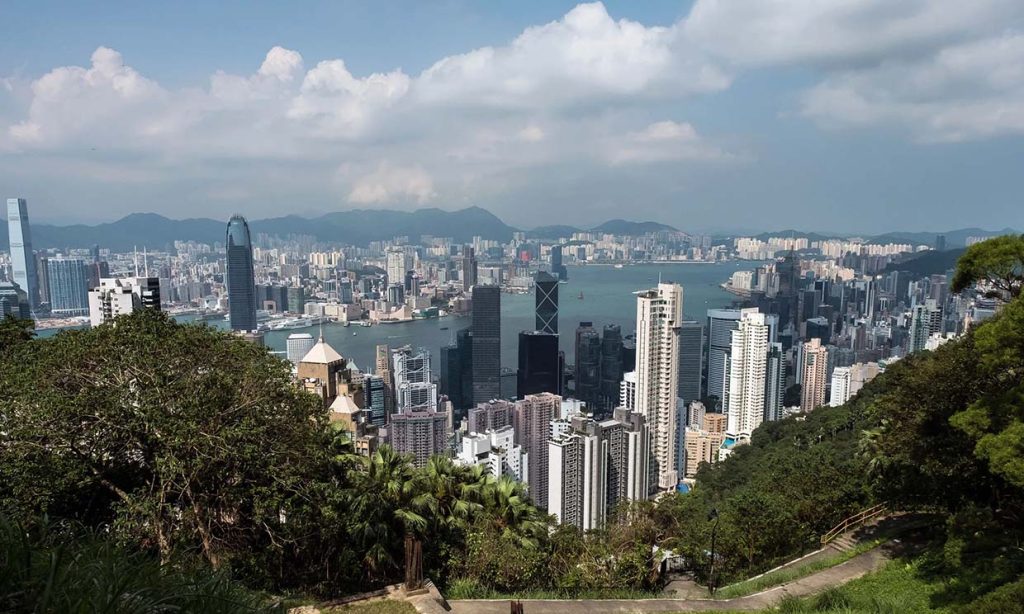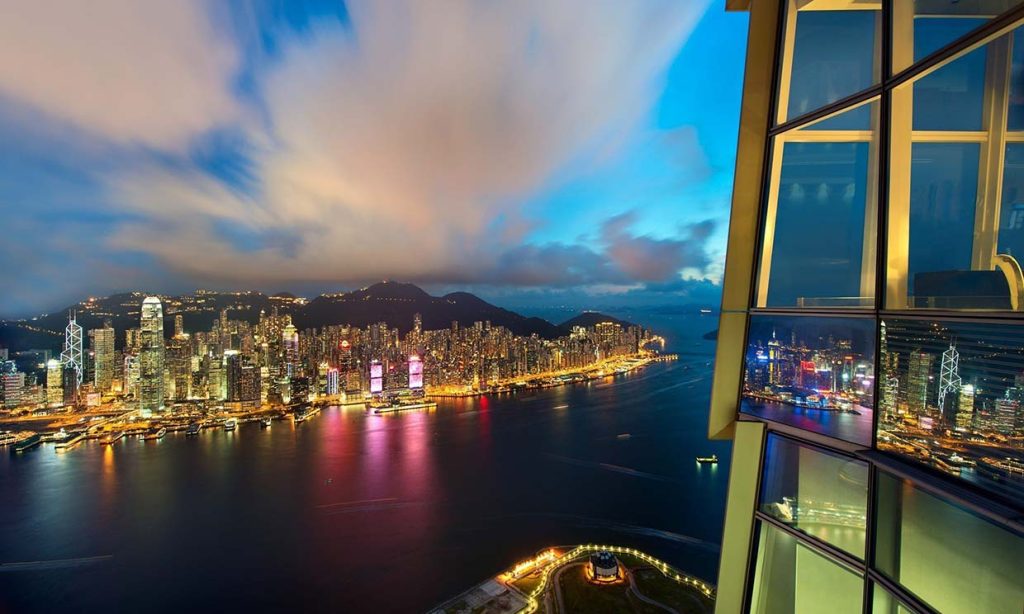I found myself drawn to the bustling metropolis of Hong Kong. In this extensive exploration, we will delve into the captivating relationship between Feng Shui and the city’s architecture, uncovering the secrets that lie within its towering structures.
Victoria Peak: A Spectacular Skyline Panorama
Victoria Peak, majestically towering over Hong Kong Island, serves as a gateway to a mesmerizing panoramic spectacle of the city. Situated at 22.2750° N latitude and 114.1603° E longitude, this iconic peak stands as a testament to the seamless integration of natural beauty and urban splendor, easily accessible from the bustling heart of the city.
Embarking on the journey to Victoria Peak is an adventure in itself, with the iconic Peak Tram offering a thrilling ascent up the steep slopes. The tram not only serves as a mode of transportation but provides an immersive experience, gradually revealing the city’s transformation as it climbs. For those seeking alternative options, buses and taxis are readily available, each offering its unique perspective of the ascent.
Upon reaching the summit, Victoria Peak unfolds a plethora of services catering to both comfort and indulgence. The site hosts an array of restaurants, allowing visitors to savor local and international cuisine amidst the stunning backdrop. Souvenir shops dot the landscape, providing mementos of this extraordinary journey. However, the crown jewel is the renowned Sky Terrace 428, a panoramic platform offering unparalleled views of Hong Kong. While basking in the visual feast, visitors should be mindful of potential crowding, particularly during peak hours when this breathtaking vista is in high demand.
Standing atop Victoria Peak, I found myself immersed in a sensory symphony of sights and sounds. The dynamic interplay of modern skyscrapers against the natural canvas of Victoria Harbour and surrounding mountains created a visual masterpiece. The panoramic view, a harmonious blend of concrete jungles and pristine landscapes, exemplified the very essence of Feng Shui—a balance between the man-made and the natural.

The undeniable advantage of Victoria Peak lies in its unparalleled views, offering a perspective that encapsulates the essence of Hong Kong. However, the drawback becomes apparent during peak tourist seasons when the site might succumb to overcrowding, slightly diminishing the otherwise sublime experience.
Access to the Sky Terrace 428 comes with varying ticket prices, with concessions for children and seniors. Savvy travelers can explore online platforms such as Klook and Viator, where combo deals are often available. These inclusive packages not only cover the entrance fee but extend to transportation and culinary experiences, presenting an economical and convenient way to enjoy the panoramic splendor of Victoria Peak.
Wong Tai Sin Temple: Architectural Harmony in Spirituality
Nestled at 22.3416° N latitude and 114.1934° E longitude in the heart of Kowloon, Wong Tai Sin Temple stands as a beacon dedicated to the Taoist deity Wong Tai Sin.
The journey to Wong Tai Sin Temple is a seamless endeavor, with convenient accessibility via MTR and buses. Alighting at the Wong Tai Sin MTR station, a brief and pleasant stroll unfolds, leading visitors directly to the temple’s spiritual embrace.
Wong Tai Sin Temple, a respite from the city’s hustle, immerses visitors in a tranquil escape. Within its sacred walls, an array of services awaits, including fortune-telling—a revered practice among locals and tourists alike. Kau Cim, a unique form of random poetry interpretation, adds an extra layer of mystique to the spiritual experience. The temple hosts various religious rituals, each intricately woven into the fabric of traditional Chinese design principles influenced by the guiding philosophy of Feng Shui. Every corner radiates architectural harmony, fostering a serene environment for worship and reflection.
My visit to Wong Tai Sin Temple left an indelible mark on my spirit. Stepping through the entrance, I was enveloped in a tranquil aura, heightened by vibrant colors and intricate details that adorned the temple’s architecture. The palpable sense of spiritual harmony, a testament to the careful application of Feng Shui principles, imbued the air with a profound sense of balance and peace.
Wong Tai Sin Temple’s cultural richness and spiritual ambiance are undoubtedly its strengths. However, the potential for overcrowding during festivals may detract from the serenity sought by visitors. Additionally, limited English signage could pose a challenge for those not familiar with Chinese languages.
The doors of Wong Tai Sin Temple graciously open to all, with entry being free of charge.
Chi Lin Nunnery and Nan Lian Garden: Symmetry in Serenity
Nestled amidst the verdant landscapes of Diamond Hill, the coordinates 22.3390° N latitude and 114.2014° E longitude mark the tranquil enclave that is home to the Chi Lin Nunnery and Nan Lian Garden—a harmonious duo inviting visitors into a serene retreat.
Accessing the Chi Lin Nunnery and Nan Lian Garden is a seamless journey, facilitated by the efficient MTR system and well-connected bus routes. Both sites graciously welcome travelers within walking distance from the Diamond Hill MTR station, ensuring a convenient and enjoyable commute.
The Chi Lin Nunnery stands as a testament to traditional Tang Dynasty architecture, a living embodiment of timeless design principles. Adjacent to this architectural marvel lies the Nan Lian Garden, a landscape adorned with classical Chinese landscaping techniques. Together, they offer a haven of tranquility, featuring meticulously maintained gardens, serene lotus ponds, and a captivating collection of bonsai. Each step through the interconnected sites is a journey through the artistry of Feng Shui, where balance and symmetry reign supreme.
Exploring the Chi Lin Nunnery and Nan Lian Garden transported me to a realm where time seemed to stand still. The meticulous symmetry of the architecture, with its traditional design echoing the grandeur of the Tang Dynasty, seamlessly blended with the tranquil surroundings of the Nan Lian Garden. Every corner exuded a sense of balance and order, a visual manifestation of the Feng Shui principles that underpin the design.
For those in search of tranquility, the Chi Lin Nunnery and Nan Lian Garden are veritable oases. However, it’s essential to note that during peak hours, the sites may experience increased foot traffic, potentially disrupting the serene atmosphere. While English information is available, it is somewhat limited, prompting visitors to immerse themselves in the visual poetry of the surroundings.
One of the notable advantages of these destinations is that admission to both the Chi Lin Nunnery and Nan Lian Garden is free. This makes it an ideal choice for budget-conscious travelers seeking a rich cultural and aesthetic experience without financial constraints. The absence of entry fees aligns with the inclusive philosophy of these sites, inviting all to partake in the beauty they offer.
Sky100: Reaching New Heights in Tsim Sha Tsui
Sky100, Hong Kong’s crowning jewel of indoor observation decks, is strategically positioned at 22.2935° N latitude and 114.1729° E longitude within the towering confines of the International Commerce Centre (ICC) in the vibrant district of Tsim Sha Tsui.
Embarking on the journey to Sky100 is a seamless affair, thanks to its central location in Kowloon. The site is easily accessible by MTR, buses, and ferries, with the Kowloon Station on the Tung Chung Line providing a direct conduit to the ICC. A prominent landmark in Kowloon, Sky100 beckons travelers with its lofty allure.
Upon reaching the summit of Sky100, visitors are treated to an unparalleled 360-degree panoramic view of Hong Kong’s mesmerizing skyline. The observation deck, adorned with floor-to-ceiling glass windows, provides an immersive experience. Interactive exhibits add an educational dimension, allowing guests to delve into the city’s rich history and architectural evolution. To complete the experience, the Sky100 Café offers a delightful setting to unwind and absorb the surroundings. The modern architectural marvel of the ICC itself serves as a harmonious backdrop, complementing the dynamic cityscape.

Standing on the observation deck of Sky100, I felt a sense of exhilaration as the city unfolded beneath me. The juxtaposition of modern skyscrapers against the vast urban expanse showcased Hong Kong’s commitment to innovation and progress. The innovative design of the ICC, with its sleek lines and contemporary aesthetic, created a compelling contrast to the traditional Feng Shui principles ingrained in the city’s culture. While the experience lacked the natural ambiance of outdoor attractions, it provided a unique perspective on the city’s dynamic evolution.
Sky100 undeniably offers a modern and unparalleled perspective of Hong Kong. The indoor setting, however, may lack the natural ambiance found in outdoor attractions. Additionally, the experience, given its commercial nature, may feel somewhat orchestrated and tailored for a mass audience.
Ticket prices for Sky100 vary, with discounts often available for children and seniors. Exploring online platforms such as Klook and KKday is beneficial as they frequently offer bundled deals that include entry to Sky100 and other attractions. These packages not only provide cost savings but also streamline the planning process for an enriched Hong Kong experience.
Embarking on a journey through Hong Kong’s architectural marvels, the intricate dance between Feng Shui and modernity unfolded at every twist and turn. From the towering heights of Victoria Peak to the spiritual sanctuary of Wong Tai Sin Temple and the timeless allure of Chi Lin Nunnery and Nan Lian Garden, each locale etched an indelible mark on my comprehension of the city’s architectural narrative.
The traditional sites, steeped in history, gracefully embraced the timeless principles of balance and harmony. Ascending to the summit of Victoria Peak, the city’s panorama beneath me became a canvas illustrating the delicate equilibrium between nature and human innovation. The Wong Tai Sin Temple, with its tranquil surroundings and traditional design, spoke volumes about the seamless fusion of spirituality and architectural aesthetics.
Yet, amidst this tradition, modern attractions like Sky100 emerged as beacons of Hong Kong’s dynamic evolution. From the vantage point of the observation deck, the urban landscape unfurled—a testament to the city’s relentless progress. The innovative architecture of Sky100, nestled within the International Commerce Centre, served as a stark but captivating contrast to the ancient philosophies of Feng Shui. The city’s skyline, etched in my memory, became a visual diary of Hong Kong’s journey through time.
As I bid farewell to the city, the seamless blend of tradition and innovation lingered in my thoughts. Hong Kong’s architectural landscape, a harmonious marriage of age-old wisdom and cutting-edge advancements, stood as a testament to the city’s resilience and adaptability. This expedition, laden with profound insights and captivating discoveries, solidified Hong Kong’s reputation as an enchanting destination for those captivated by the enigma of Feng Shui and its profound impact on the tapestry of architectural wonders.